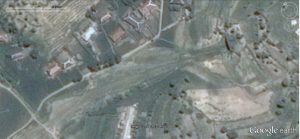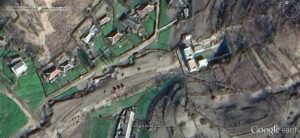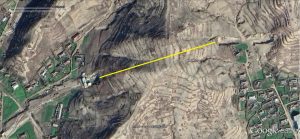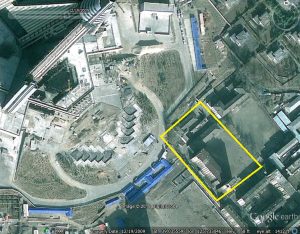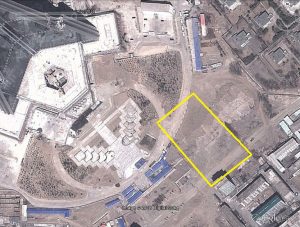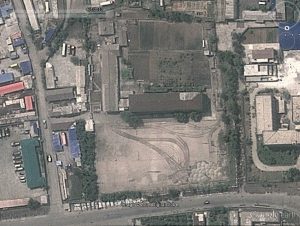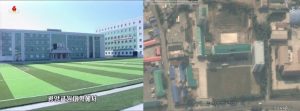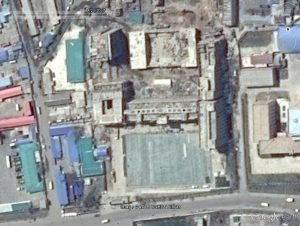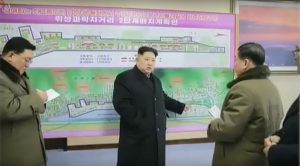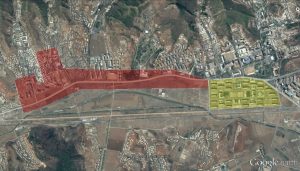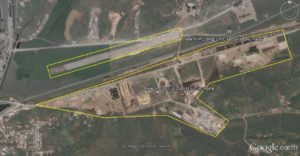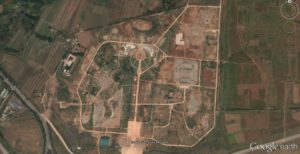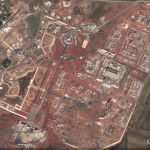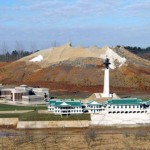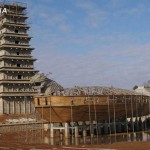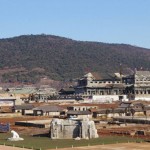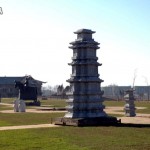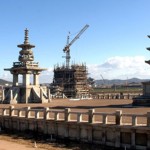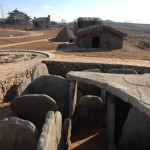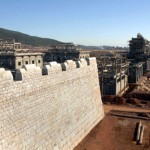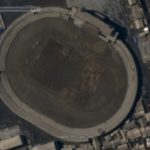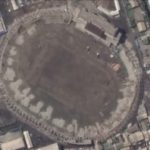UPDATE 6 (2018-3-15): Planet Labs (@planetlabs) has posted some March 2018 imagery of construction of the Kalma Coastal Tourist Area construction site.
There appear to be two staging areas for the construction site where workers live and supplies are stored.
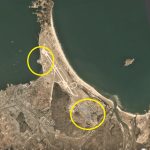
Here are close-ups of the two large staging areas circled in yellow in the image above:
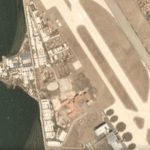
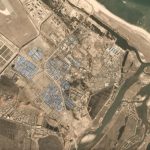
I overlaid recent Planet images onto Google Earth and outlined the building and facility construction site. The coastal resort is taking place in the area outlined in yellow below:
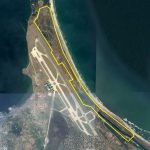
Here are a couple of Planet images of the construction site:
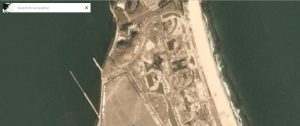
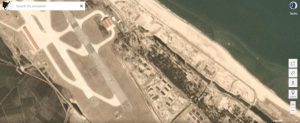
I believe this project is supposed to be completed in about a year, so it will be worthwhile to check in on it periodically with Planet images to see how the project is developing.
UPDATE 5 (2018-2-2): The web page DPRK Today conducted an interview with a North Korean official about the Kalma project. NK News offers a good English-language article about the interview here.
UPDATE 4 (2018-2-1): The Pyongyang Times offers information on the Kalma tourist area (like construction is expected to be completed in one year):
Wonsan-Kalma area shows promise as seaside resort
The development of the Wonsan-Kalma coastal tourist zone is a priority project in the DPRK this year.
Seaside resorts are tourist destinations that are found by the coast.
The most suitable places for them are those with conditions favourable for such seaside tourist activities as swimming, sunbathing, angling, yachting, boating, motorboating, surfing and scuba diving in terms of the percentage and duration of sunshine, number of days with average temperature of 18-20℃ and with no or weak wind and the condition of seashore. Especially those with sandy beaches are so suitable for coastal tourism that many countries develop such areas into seaside resorts.
Currently, such resorts hold a significant proportion of the world-class natural tourist destinations and most of summer vacationers tour the seaside.
In the DPRK, many renowned seaside scenic attractions, including Songdowon and Lake Sijung of Kangwon Province, Majon of South Hamgyong Province and Ryongsupho of South Hwanghae Province, turned into coastal tourist centres.
The Wonsan-Kalma area in Kangwon Province is also a very promising seaside resort.
The Kalma peninsula in the southern part of the Wonsan Bay is an attached island which was formed by the wave-driven accumulation of granitic sand from the Namdae River.
The northern part of the peninsula which stands long from south to north consists in gently rolling hills and the coastline is mostly straight and smooth.
To the north lies the Hodo peninsula which stretches out from the opposite direction and in between there are Sin, Tae and other islets, serving as a natural breakwater that protects the port of Wonsan.
There is a scenic attraction called Myongsasipri which means a famous sand beach stretching for 4 kilometres in the Kalma peninsula.
A goldenrain tree rare to be found in the eastern coastal areas of the country stands at the entrance to the beach which is dotted with sweet briars. The red flowers in full bloom along the seaside surrounded by tall pines and clear blue waves of the East Sea form a harmonious whole to present a spectacular beauty.
The construction of the seaside resort in the Wonsan-Kalma area with Kalma airport will help satisfy the demands of local and foreign tourists and provide an ideal place for stopover between different tourist destinations and Wonsan-Mt Kumgang International Tourist Zone.
At present, preparations are being pushed ahead to complete as early as possible the Wonsan-Kalma project which will mark a turning point in raising the country’s tourism to the world level.
UPDATE 3 (2018-1-31): The Daily NK reports that construction on the Kalma tourist zone has started, and it looks like they are right. According to a recent article:
The North Korean authorities are mobilizing ordinary citizens and military conscripts alike in a push to accelerate construction of the “Wonsan Kalma Shore Tourist Zone” situated on the country’s east coast. Sources inside North Korea report that the authorities have conveyed their intentions to complete the project before the July 27 “Victory Day” holiday, which is referred to as National Korean War Veterans Armistice Day in South Korea.
The beach resort project, along with Kalma Airport and the Masik Pass Ski Resort, all appear to be part of a larger plan by Kim Jong Un to address economic difficulties by generating more tourism revenue. He made this clear in his 2018 New Year’s address, saying, “This year, service personnel and residents should join efforts to complete the construction of the Wonsan-Kalma coastal tourist area in the shortest period of time.”
“The authorities have mobilized 120,000 military members and 20,000 ordinary citizens for the Wonsan construction project,” a source in China close to North Korean affirms told Daily NK on January 28. “People are worried over implications of another ‘speed battle’ (intense construction mobilization) after Kim Jong Un’s order to complete the project by July 27.”
Read the rest of the article here.
If North Korea was engaging in this sort of work, we should see evidence of it–and we can via Planet Labs. Pictured below is a plot of land on the south end of the Kalma Airport runway. On the top is the Google Earth image dated 2017-5-19. On the bottom is the Planet Labs image dated 2018-1-31:
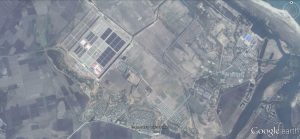
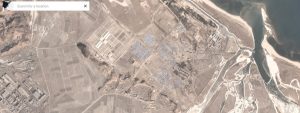
The bottom photo clearly shows a large compound of temporary housing for construction workers. This kind of facility can be seen at all of North Korea’s large scale construction projects. The coordinates are 39.144608°, 127.503932° for those that are interested.
It is still difficult to see any significant construction taking place on the northern end of the peninsula. Planet imagery in this case is rather limited, but it also appears the construction project itself is rather recent. In the Planet image below, dated 2018-1-12, we can see just how much worker housing has been constructed in just the last two weeks.
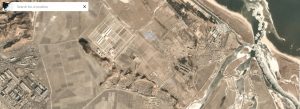
(Note: Planet Labs created a .gif of the construction site. You can see it on Twitter here.)
If the Daily NK is correct, and this is the “Wonsan Kalma Shore Tourist Zone,” and not part of the “Wonsan-Mt. Kumgang Tourist Zone,” then this indicates that plans for the area are still changing. This will be an interesting area to watch.
Here are previous posts I have done on the Kalma Peninsula and Wonsan-Mt. Kumgang International Tourist Zone. Here is a relevant article I wrote for NK News back in 2013.
UPDATE 2 (2018-1-31): KCNA releases some propaganda posters for the Kalma project:
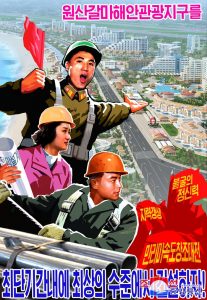
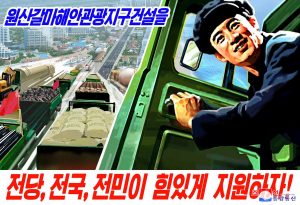
These posters give the impression that this project as ambitious as any of the major construction projects they have done in Pyongyang (Mansudae parts 1 and 2, Unha Scientist Street, Satellite Scientist Street, Mirae Scientist Street and Ryomyong Scientist Street). I previously posted about Part 2 of the Satellite Scientists Street, but it looks that that project will take a back seat to this one.
The previously announced (2015) “Kalma Street” project appears to have stalled in 2017, and this new tourist zone is apparently unrelated. It is unclear if the Kalma Street project will be completed or if it has been scrapped.
UPDATE 1 (2018-1-25): KCNA announces more information on the Wonsan-Kalma Coastal Tourist Area:
Wonsan-Kalma Coastal Tourist Area to Be Built in DPRK
A tourist resort is to be built in the Wonsan-Kalma coastal area in Kangwon Province, the DPRK on a large scale.
The Wonsan-Kalma area is good for coastal tourism.
The Kalma Peninsula in the southern part of Wonsan bay is the connecting bar formed with granite sand.
The northern part of the peninsula ranging north and south is low hill and its coastline is straight and smooth as a whole.
It faces the Hodo Peninsula to the north and Sin, Tae and other islets are located between them which serve as seawall of Wonsan Port.
There are four-kilometer-long famous sandy beach resorts called Myongsasipri and modern Kalma Airport in the peninsula.
When the tourist area is built, it will satisfy the demand of domestic and foreign tourists and will be the most ideal place to link various tourist destinations to the Wonsan-Mt Kumgang international tourist zone.
Now, a preparatory work is brisk for completing the construction of the Wonsan-Kalma coastal tourist area, a radical turn in putting the country’s tourism on world level.
ORIGINAL POST (2016-7-15): KCNA announces new special economic zone:
Kalma Area of DPRK to Turn into Tourist Resort
Pyongyang, July 15 (KCNA) — The Kalma area, located on the central east coast of Korea, will be turned into a tourist resort.
The area boasts of four-kilometer-long beach resort, not far away from such scenic spots as Mt. Kumgang, Lake Sijung, Chongsokjong and Lagoon Samil and the Masikryong Ski Resort.
The DPRK Law on Economic Development Parks, enacted in May Juche 102 (2013), is applicable to the area. Under this law, foreign investors are allowed to conduct their business activities independently in the area.
An international friendship air festival is to take place in Wonsan City, adjacent to the Kalma area, at the end of September.
The official media hinted at this project a few days prior in a report on the Mubong Mubong Special Zone for International Tourism.












